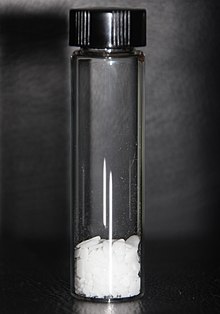
| |

| |

| |

| |
| Names | |
|---|---|
| Preferred IUPAC name
Triphenylphosphane[1] | |
| Identifiers | |
3D model (JSmol)
|
|
| ChEBI | |
| ChemSpider | |
| ECHA InfoCard | 100.009.124 |
| EC Number |
|
PubChem CID
|
|
| RTECS number |
|
| UNII | |
| UN number | 3077 |
CompTox Dashboard (EPA)
|
|
| |
| |
| Properties | |
| C18H15P | |
| Molar mass | 262.292 g·mol−1 |
| Appearance | White Solid |
| Density | 1.1 g cm−3, solid |
| Melting point | 80 °C (176 °F; 353 K) |
| Boiling point | 377 °C (711 °F; 650 K) |
| Insoluble | |
| Solubility | organic solvents |
| Acidity (pKa) | 7.64[2] (pKa of conjugate acid in acetonitrile)
2.73[3] (pKa of conjugate acid, aqueous scale) |
| -166.8·10−6 cm3/mol | |
Refractive index (nD)
|
1.59; εr, etc. |
| Structure | |
| Pyramidal | |
| 1.4 - 1.44 D [4] | |
| Hazards | |
| GHS labelling: | |
 
| |
| Danger | |
| H302, H317, H350, H412 | |
| P201, P202, P261, P264, P270, P272, P273, P280, P281, P301+P312, P302+P352, P308+P313, P321, P330, P333+P313, P363, P405, P501 | |
| NFPA 704 (fire diamond) | |
| Flash point | 180 °C (356 °F; 453 K) |
| Safety data sheet (SDS) | Fisher Scientific |
| Related compounds | |
Related tertiary phosphines
|
Trimethylphosphine Phosphine |
Related compounds
|
Triphenylamine Triphenylarsine Triphenylstibine Triphenylphosphine oxide Triphenylphosphine sulfide Triphenylphosphine dichloride Triphenylphosphine selenide Pd(PPh3)4 |
Except where otherwise noted, data are given for materials in their standard state (at 25 °C [77 °F], 100 kPa).
| |
Triphenylphosphine (IUPAC name: triphenylphosphane) is a common organophosphorus compound with the formula P(C6H5)3 and often abbreviated to PPh3 or Ph3P. It is versatile compound that is widely used as a reagent in organic synthesis and as a ligand for transition metal complexes, including ones that serve as catalysts in organometallic chemistry. PPh3 exists as relatively air stable, colorless crystals at room temperature. It dissolves in non-polar organic solvents such as benzene and diethyl ether.
- ^ International Union of Pure and Applied Chemistry (2014). Nomenclature of Organic Chemistry: IUPAC Recommendations and Preferred Names 2013. The Royal Society of Chemistry. p. 431. doi:10.1039/9781849733069. ISBN 978-0-85404-182-4.
- ^ Haav, Kristjan; Saame, Jaan; Kütt, Agnes; Leito, Ivo (2012). "Basicity of Phosphanes and Diphosphanes in Acetonitrile". European Journal of Organic Chemistry. 2012 (11): 2167–2172. doi:10.1002/ejoc.201200009. ISSN 1434-193X.
- ^ Allman, Tim; Goel, Ram G. (1982). "The Basicity of Phosphines". Canadian Journal of Chemistry. 60 (6): 716–722. doi:10.1139/v82-106.
- ^ Warchol, M.; Dicarlo, E. N.; Maryanoff, C. A.; Mislow, K. (1975). "Evidence for the Contribution of the Lone Pair to the Molecular Dipole Moment of Triarylphosphines". Tetrahedron Letters. 16 (11): 917–920. doi:10.1016/S0040-4039(00)72019-3.
